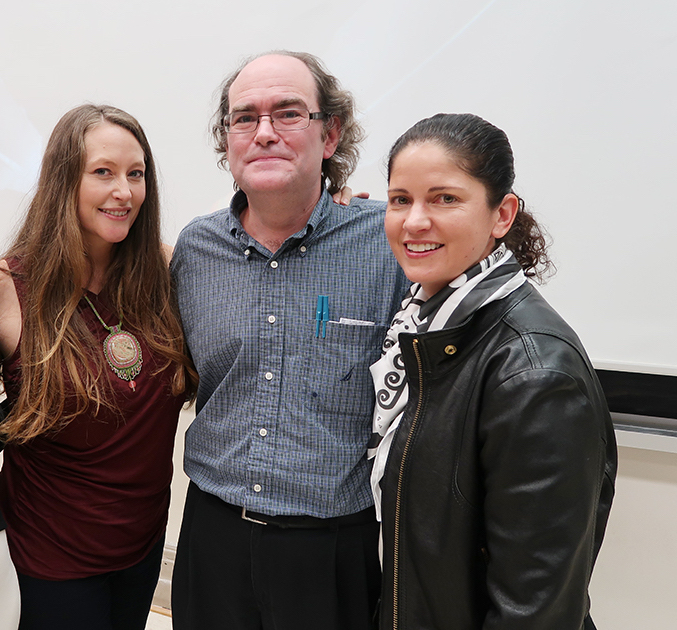Breadcrumbs
- Home
- MD/PhD Program
- News
- Advancing Indigenous Medical Education: spotlight on Dawn Maracle
Advancing Indigenous Medical Education: spotlight on Dawn Maracle

Andrea Concil

PHOTO CREDIT: Rosalie Favell 2016
Indigenous Undergraduate Medical Education Program Coordinator Dawn Maracle, BAH, B.Ed., M. Ed. joined the MD Program in July 2016 (covering a maternity leave until August 2017), Dawn shares her passion for both health and education and how she is helping to advance Indigenous Medical Education.
 Describe your role in the MD Program?
Describe your role in the MD Program?
As a member of the Office of Indigenous Medical Education, my primary goal is to proactively reach out, recruit, support and mentor Indigenous students for the MD Program. Our office supports Indigenous medical students’ success by facilitating access to a rich academic curriculum, as well as a range of social, financial, cultural and academic supports that address the particular experience of Indigenous students in post-secondary and medical school environments. Furthermore, in my role, I work towards sharing and incorporating an Indigenous health perspective throughout the curriculum.
My major responsibilities include development, implementation and maintenance of a multi-faceted outreach and recruitment strategy; cultivating and establishing strong relationships with external and internal organizations such as government agencies, school boards, First Nations House and the Indigenous Studies Program; developing and implementing a professional mentoring program; providing counselling and support to Indigenous applicants and medical students; identifying and drafting funding proposals to foundations and government agencies to ensure the sustainability of the MD Program Indigenous student outreach, recruitment and mentoring programs.
Why did you decide to join the MD Program?
I decided to join the program, because health is a great interest of mine. Having worked in Indigenous communities focusing primarily on education, health and governance (as well as social justice, women’s issues and the arts) for nearly a quarter of a century, I’ve come to know that education and health are inextricably linked. As a cancer survivor and Kanienkeha (Mohawk) woman with an invisible disability who is a single mother, I am consistently trying to balance work life with family life in an effort to balance my mental, physical, emotional and physical self. I do this while I try to model Haudenosaunee teachings with my daughter, and talk to her about managing issues as they arise.
I believe that education can heal. Learning about the real history of Indigenous – settler relations in this country has been monumentally enlightening for me. Now with the Truth and Reconciliation Commission’s Final Report and Calls to Action, we all have a social responsibility to teach about our real collective history, in order that we may all learn to relate to one another better for the purpose of raising awareness and humility, and to come together with Good Minds so that we may begin building healthy relationships in our classrooms, institutions, communities, cities and country.
I’ve worked in Indigenous student support for a number of years, and as someone who was a professional student for a time, I greatly understand and appreciate that without Indigenous student supports, space, teachers, curriculum, and cultural safety, I wouldn’t be here today. I’m happy to ‘pay it forward’ by supporting Indigenous students holistically.
What is your favourite part about your role?
My favourite part of this role is everything! I love knowing that I am bringing about positive changes to the way medical education is delivered – whether helping shape the curriculum, supporting advocacy initiatives to increase diversity, or facilitating the Blanket Teaching, a teaching tool to share Canadian history from an indigenous perspective, to staff and faculty in Medicine, Occupational Therapy, and other areas of health education.
I am also excited about our Hallway Diversity Project, where Dean Trevor Young has supported our endeavor to increase the visibility of faces of graduates from this institution who succeeded despite a likelihood of many obstacles to access and graduate from University of Toronto Medicine. When Indigenous and underrepresented groups can see themselves reflected in their institution in safe and normalized ways, we provide a more welcoming environment for them to succeed. Look for the display in the Medical Sciences Building in early 2017.
How do you help to support our students to become future academic health leaders who will contribute to our communities and improve the health of individuals and populations through the discovery, application and communication of knowledge?
Providing space, and giving support to Indigenous grants and bursaries, family and community support, visibility, building relationships, enhancing curriculum, getting everyone excited about reconciliation, and setting goals to support our students holistically. Through my work with the Office of Indigenous Medical Education, we are helping equip all MD Program graduates with knowledge around cultural safety, and increasing awareness and sensitivity.
Outside of your role at the MD Program, what are some of your interests or hobbies?
Outside of my role here at U of T, I have many interests and hobbies. I am a dancer, cheerleader, teacher, lifelong learner, researcher, writer, public speaker and emcee, and working in Indigenous Cancer Care and tobacco cessation are things I am passionate about. I also sit on the Board of Directors for Native Child and Family Services, and as well, I contribute to the Toronto District School Board Aboriginal Community Advisory Committee to ensure we are building responsible and effective organizations, relationships, and communities for our current and future learners.
News


